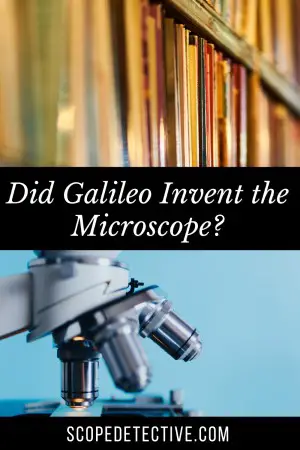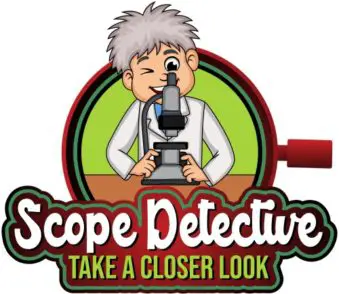No, Galileo did not invent the microscope. He was one of the first Italians who worked with microscopes and created his own compound microscopes in the early 1600s. But the compound light microscope was invented in the Netherlands sometime around 1590 and patented in 1608.
 Nevertheless, Galileo was an early microscope developer and user, and it was in fact his occhiolino microscope that he presented to the Accademia dei Lincei in 1624 that inspired the term ‘microscope’.
Nevertheless, Galileo was an early microscope developer and user, and it was in fact his occhiolino microscope that he presented to the Accademia dei Lincei in 1624 that inspired the term ‘microscope’.
Unfortunately there are none of Galileo’s early microscopes left today (or at least none that we know of!)
Overall, it seems Galileo was more interested in his telescopes and looking at the stars than he was at looking at the microcosmos. And today we tend to associate Galileo with the stars more than the microorganisms under the microscope.
> This article is part of our series on the history of microscopy
Did Galileo Invent the Microscope?
1. The First Compound Microscope – Not Galileo!
Eyeglass lenses have been around since about the 13th century. They were developed in Italy, starting with the monocle before evolving into the two-lens eyeglass like glasses we wear today.
The eyeglass lens was the precursor to the compound microscope, and in fact it was spectacle makers who developed the first microscopes.
The compound microscope is a microscope that uses two lenses (today we usually have an ‘ocular’ and ‘objective’ lens). With two lenses, you can multiply the magnification and achieve much better magnification than if you only had the single lens.
For example, if your ocular lens (the one closest to your eye) is 10x and your objective lens (the one closest to the specimen) is 4x, then your total magnification will be 10 x 4 = 40x magnification.
It’s not clear who invented the first compound microscope, but we know it was from one of two neighboring spectacle maker shops.
The first candidate was Hans Lippershey who patented his microscope in 1608. Lippershey is said to have invented the microscope after observing two children in his spectacle show placing two lenses together and marvelling at how well they could magnify things in the shop.
The second candidate was Zacharias Janssen. He was another spectacle maker from Middelberg in the Netherlands.
While Zacharias Janssen never claimed to have invented the microscope himself, his son – Johannes Zachariassen – was adamant that it was his father who was the true inventor. A follow-up investigation in 1655 by diplomat Willem Boreel found it was in fact Janssen who invented the microscope, this is clouded by the fact Boreel was a childhood friend of his son Johannes.
So, no one really knows who really invented the microscope.
> Read About this Story in Depth: Who Invented the Microscope?
2. Galileo’s Microscopes
It’s likely that Galileo read about Lippershey’s patent publication for telescopes and microscopes and set to work duplicating his works in Italy.
And while Galileo is well known for having created many microscopes, he never laid claim to inventing the microscope. It’s the mere fact that Galileo was an early and prolific telescope and microscope user that he sometimes is mistaken for the inventor.
Galileo’s first microscopes were likely simply inverted telescopes, which he later refined after seeing one constructed by Cornelis Drebbel in Rome in 1624,
This improved microscope achieved about 30x magnification and was dubbed the occhiolino (little eye) by Galileo. This particular microsocpe had three bi-convex lenses.
Galileo’s occhiolino was presented to Prince Federico Cesi of the Accademia dei Lincei (literally: The Academy of the Linx-eyed) in 1624, and the following year, the occhiolino was re-named the ‘microscope’ (to achieve linguistic parity to the already named ‘telescope’) by the Secretary of the Accademia dei Lincei, Giovanni Faber.
3. Galileo vs Van Leeuwenhoek
Another person who is often wrongly credited with developing the first microscope is Antonie van Leeuwenhoek. Van Leeuwenhoek did not in fact create the microscope, but is considered the ‘father of microscopy’.
Van Leeuwenhoek was on the stage somewhat later then Galileo, around the mid-1600s. Van Leeuwenhoek created single lens microscopes with tiny glass balls that he used to inspect thread in his weaver’s shop. These microscopes could achieve magnification up to 200x.
With his highly magnifying microscopes, van Leeuwenhoek was the first to identify bacteria under the microscope, as well as making some revolutionary observations of muscle fibres and red blood cells.
Conclusion
While Galileo was a revolutionary scientist and polymath of his time, he was not the inventor of the microscope – or even the telescope! Nevertheless, we must credit Galileo as one of the first microscopists who paved the way for scientists and hobbyists of today who love to look under a microscope to explore the tiny world before our eyes.
He will, however, be most remembered for his work with telescopes, including identifying the four moons of Jupiter, craters on our moon, and for proposing the radical idea that the earth revolves around the sun.
References
[1] https://link.springer.com/article/10.1007/s10686-009-9142-0
[2] http://mirror2.polsri.ac.id/wiki/wp/o/Optical_microscope.htm
Hi, I’m Chris and I run things around here! I share all my microscopy experiments, microscope information and tricks, how to guides, and microscope reviews in the articles on this site. Browse around to see what you like (I recommend the experiment ideas section) or connect with me on any of the social platforms listed below.

